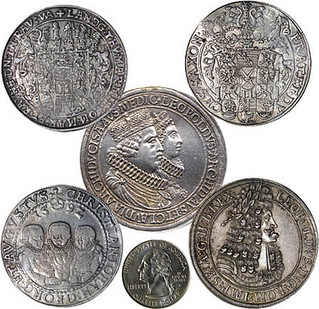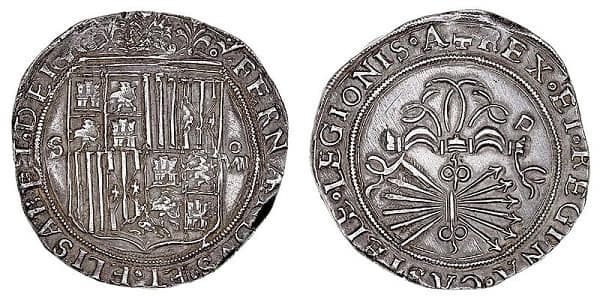
PREV ARTICLE
NEXT ARTICLE
FULL ISSUE
PREV FULL ISSUE
V25 2022 INDEX E-SYLUM ARCHIVE EIGHT REALES: THE FIRST INTERNATIONAL CURRENCYThis article on the long history and influence of the Spanish dollars was published by Hussein Larreal at coleccionistasdemonedas.com (in Spanish), and in English on the American Numismatic Association site. Here's an excerpt - see the complete article online for more. -Editor More than a currency, the "Spanish dollars" were the basis of American national currencies: the multiple Latin "pesos" and the US "dollar" are successors of a Spanish currency whose respect transcended the great differences between societies of its time.
How the first reals of eight arose The reals of eight arise in a very particular way. On the one hand, in Austria, in 1486 Sigismund of Habsburg promoted the minting of large silver coins: the guldiner , weighing 31.93 grams and 937 thousandths of a law. These were not widely accepted at first, but served as inspiration for Bohemia to later produce the thaler , weighing 27 grams and 900 thousandths of a fine. These would be successful in Germanic lands, so Emperor Maximilian of Habsburg used them for propaganda purposes. In parallel, the Catholic Monarchs were in charge of modernizing the Castilian monetary system through the Pragmatics of Medina del Campo (1497), a key moment in the history of Spanish coins, which detailed how to make silver reals and established the characteristics that would make them accepted . all over the world ; manufacturing its multiples was not yet contemplated. Another important fact to consider is the founding of Mexico City and the construction of its mint. In 1537 he was authorized to mint different multiples of the real; For this reason, in 1538 they produced a few reals of eight that immediately ceased to be worked due to the difficulties involved in making them. Their existence was doubted for a long time , until three specimens were found in a shipwreck at the end of the 20th century . As for Spanish pieces, the exact moment in which they began to be produced is unknown, but we can know that they appeared under the reasons defined by the Catholic Monarchs: Carlos I used the fame of the copies produced by his grandparents to mint them, with the intention that people accept them. As they are undated, these numismas must be dated by studying the assayers' marks. María Ruiz Trapero, Professor of Epigraphy and Numismatics at the Complutense University of Madrid, pointed out that all the known European pieces are after 1543, but this does not exclude that they were minted earlier.
To read the complete article (in English or Spanish), see:
Wayne Homren, Editor The Numismatic Bibliomania Society is a non-profit organization promoting numismatic literature. See our web site at coinbooks.org. To submit items for publication in The E-Sylum, write to the Editor at this address: whomren@gmail.com To subscribe go to: https://my.binhost.com/lists/listinfo/esylum All Rights Reserved. NBS Home Page Contact the NBS webmaster 
|


